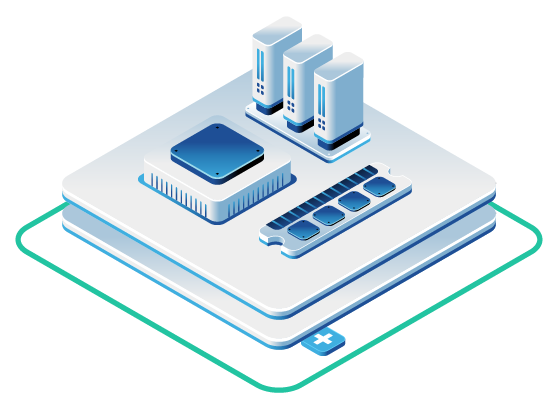In this article
- The Real-Time Fraud Detection Challenge
- The Infrastructure Requirements for Fraud Detection
- Machine Learning Models for Fraud Detection
- The Technology Stack
- Cost Predictability for Fraud Detection
- Data Center Locations for Low-Latency Access
- Security and Compliance Architecture
- Infrastructure as Code for Rapid Deployment
- Real-World Implementation Patterns
- Performance Benchmarks and Monitoring
- Addressing Class Imbalance in Training Data
- Future-Proofing Your Fraud Detection System
- Getting Started with Fraud Detection Infrastructure
- Build Your Fraud Detection Infrastructure With OpenMetal
Financial fraud has evolved into a sophisticated threat that demands equally sophisticated responses. As your organization processes millions of transactions daily, you face an urgent question: How can you identify fraudulent activity in real-time without disrupting legitimate customers? The answer lies in combining big data analytics with dedicated infrastructure designed specifically for the low-latency, high-throughput demands of modern fraud detection systems.
The Real-Time Fraud Detection Challenge
Your fraud detection system must make authorization decisions in under 100 milliseconds while simultaneously analyzing historical patterns across millions of transactions. Big data analytics leverage vast volumes of structured and unstructured data from transaction logs, user behavior patterns, and external threat intelligence feeds to detect anomalies and suspicious activities. This isn’t a batch processing challenge, it’s a real-time decision-making problem where milliseconds matter.
When a customer swipes their card at a point-of-sale terminal or completes an online checkout, your fraud scoring models must execute within tight time windows. Any latency spike can result in declined legitimate transactions, frustrated customers, and lost revenue. Public cloud environments introduce performance variability through multi-tenant resource sharing—the “noisy neighbor” problem where other workloads on shared hardware cause unpredictable latency during peak periods like Black Friday or flash sales.
OpenMetal’s dedicated bare metal infrastructure eliminates this variability entirely. Each server provides dedicated CPU cores, memory, and NVMe storage with consistent IOPS. Your fraud detection workloads never compete for resources with other tenants, ensuring predictable sub-100ms query latencies even during transaction surges.
The Infrastructure Requirements for Fraud Detection
Network Architecture for Real-Time Data Flow
Real-time fraud detection mechanisms enable organizations to monitor transactions as they occur, identifying patterns indicative of fraudulent activities and enabling immediate response to prevent fraud before it results in financial losses.
Your fraud detection architecture must continuously move data between multiple system components: real-time databases receiving transaction streams, analytical databases querying historical patterns, Kafka topics distributing events to microservices, and ML model feature stores maintaining synchronized state. This east-west traffic between services often exceeds the volume of north-south traffic from end users.
OpenMetal’s dual 10 Gbps NICs deliver 20 Gbps aggregate bandwidth with completely unmetered private network traffic. You can replicate data between real-time and analytical databases, stream events between Kafka topics and fraud scoring microservices, and synchronize ML model state across distributed nodes without incurring bandwidth charges. This networking architecture supports fraud systems that must enrich payment data with third-party signals, execute graph queries to detect fraud rings, and maintain synchronized feature stores—all while meeting sub-second SLAs.
Memory and Storage for In-Memory Processing
A comprehensive study on fraud detection using big data demonstrates that transaction monitoring systems continuously monitor incoming transactions in real-time, flagging suspicious activities based on predefined rules, thresholds, or machine learning models.
When validating a payment transaction, your system must instantly access:
- Customer risk profiles and historical behavior patterns
- Device fingerprints and geolocation data
- Network relationship graphs showing connections between accounts
- Real-time feature calculations from streaming data
High-memory configurations up to 2TB DDR5 RAM enable in-memory fraud model scoring and feature store caching, eliminating database round-trips during transaction validation. Your Redis instances can hold complete customer risk profiles in memory, while ClickHouse columnar databases cache hot data for instant analytical queries. NVMe storage delivers the sustained IOPS required for simultaneous reads (querying historical customer behavior) and writes (logging transaction attempts) during live payment validation.
Machine Learning Models for Fraud Detection
Supervised Learning for Pattern Recognition
Recent research from Rochester Institute of Technology evaluated multiple machine learning approaches for fraud detection, finding that Random Forest models achieved F1-scores exceeding 99% when trained on balanced datasets using techniques like SMOTE (Synthetic Minority Over-sampling Technique) to address class imbalance.
Your fraud detection models learn from labeled historical data where fraudulent and legitimate transactions are marked. Random Forest and Gradient Boosting algorithms excel at identifying complex patterns:
- Unusual transaction amounts for specific merchant categories
- Geographic anomalies (transactions from unexpected locations)
- Velocity patterns (rapid succession of transactions)
- Device and behavioral fingerprint mismatches
These ensemble methods aggregate predictions from multiple decision trees, reducing false positives while maintaining high recall rates for actual fraud. The models handle high-dimensional feature spaces well. You can input hundreds of features including transaction metadata, user behavior signals, and third-party data enrichment without extensive feature engineering.
Deep Learning for Complex Pattern Recognition
Studies analyzing financial fraud detection have shown the increasing utilization of artificial neural networks in identifying fraudulent activities within e-commerce platforms, particularly for detecting sophisticated fraud schemes that evade rule-based systems.
Deep neural networks capture non-linear relationships between features that traditional algorithms miss. Your fraud detection architecture might deploy:
Real-time scoring models: Lightweight neural networks with 2-3 hidden layers that execute inference in under 10ms, making binary fraud/not-fraud predictions on every transaction
Behavioral analysis models: Recurrent neural networks (RNNs) or Long Short-Term Memory (LSTM) networks that analyze sequences of user actions to detect account takeover attempts
Anomaly detection models: Autoencoders trained on legitimate transaction patterns that flag transactions deviating significantly from learned normal behavior
OpenMetal’s infrastructure provides the computational horsepower for both training and inference. You can run GPU-accelerated training jobs on dedicated hardware, then deploy optimized models to CPU-based inference servers handling production traffic.
Graph Analytics for Fraud Ring Detection
User behavior patterns encompass data related to how users interact with digital platforms, including login times, browsing history, and purchase behavior, enabling detection of suspicious activities.
Sophisticated fraud often involves networks of connected accounts, devices, and payment methods. A single fraudster might control dozens of accounts, using them to conduct fraudulent transactions while appearing as separate legitimate users in isolated analysis.
Graph databases like Neo4j map relationships between entities:
- Accounts sharing the same device fingerprints
- Multiple accounts registered to the same physical address
- Payment methods used across seemingly unrelated accounts
- Transaction networks showing fund movement patterns
Your graph-based fraud detection queries traverse these relationships in real-time, identifying fraud rings that coordinate attacks across multiple accounts. When one account exhibits suspicious behavior, you can instantly flag related accounts for enhanced scrutiny or preventive blocking.
The Technology Stack
Stream Processing Architecture
Streaming data processing and complex event processing technologies enable organizations to analyze transaction data as it flows through systems in real-time.
Your fraud detection pipeline processes transaction events through multiple stages:
Kafka ingestion layer: Transaction events arrive from payment gateways, mobile apps, and web checkouts at rates of thousands per second. Kafka topics partition this stream across multiple consumers for parallel processing.
Flink real-time processing: Apache Flink jobs perform stateful stream processing—calculating rolling aggregates, maintaining session windows, and enriching transactions with external data. Building high-throughput data ingestion pipelines requires infrastructure that can sustain consistent write throughput without backpressure.
Redis feature stores: Pre-calculated features from historical data live in Redis, providing microsecond lookups during transaction scoring. Customer risk scores, device reputation scores, and merchant trust ratings are instantly available to fraud models.
ClickHouse analytics: While real-time scoring uses simplified models for speed, ClickHouse enables complex analytical queries across months of historical data. Your fraud analysts can investigate patterns, generate reports, and discover new fraud techniques by querying billions of records in seconds.
Multi-Database Architecture
Different components of your fraud detection system have different database requirements:
PostgreSQL for transactional data: ACID-compliant storage for customer accounts, payment methods, and case management
Cassandra for event logging: High-write-throughput storage for every transaction attempt, API call, and system event
Elasticsearch for investigation: Full-text search across transaction data, allowing fraud analysts to quickly find related events during investigations
Neo4j for relationship analysis: Graph storage and querying for fraud ring detection
OpenMetal’s infrastructure supports running these databases on dedicated hardware without resource conflicts. Your PostgreSQL instances get consistent disk IOPS for transaction processing. Cassandra clusters scale horizontally across multiple servers with high-bandwidth networking. Elasticsearch nodes access data on local NVMe storage for fast searches.
Cost Predictability for Fraud Detection
Eliminating Variable Cloud Costs
Public cloud fraud detection deployments face unpredictable costs:
- Per-request charges for fraud scoring API calls
- Egress fees when transmitting decisions to payment processors
- Premium storage tier costs for guaranteed IOPS
- Data transfer charges between regions
- Bandwidth costs for real-time data replication
Big data analytics platforms are highly scalable, allowing organizations to analyze massive volumes of data quickly and efficiently, adapting to changing fraud patterns and handling spikes in transaction volumes without compromising performance.
OpenMetal’s fixed-cost model with 95th percentile egress billing eliminates these surprises. You pay predictable monthly costs for your infrastructure, regardless of internal data transfer volume. Financial services and e-commerce companies report 30-60% infrastructure cost savings compared to public cloud deployments while achieving better P99 latencies for fraud decisioning.
Scaling Economics
As your transaction volume grows, public cloud costs scale linearly or worse. You pay more for each additional API call, each additional gigabyte of data transfer, and each additional IOPS. Your costs are directly proportional to success.
With OpenMetal’s dedicated infrastructure, scaling happens through capacity planning rather than variable costs. When you need more capacity, you add servers at predictable monthly rates. Between capacity additions, your costs remain constant even as transaction volumes increase 10x or 100x.
Data Center Locations for Low-Latency Access
Transaction data contains valuable information about transaction amounts, timestamps, locations, and parties involved, which organizations analyze to identify patterns indicative of fraudulent activities.
Your fraud detection system’s latency includes network round-trips to payment gateways, card networks, and third-party data providers. Every millisecond of latency increases the risk of timeout-driven declines.
OpenMetal operates data centers in strategic financial hubs:
Ashburn, Virginia: Adjacent to major US financial institutions, card networks, and payment processors. Minimal latency to the infrastructure handling the majority of US electronic payments.
Los Angeles, California: Serving the West Coast fintech ecosystem with low-latency access to tech companies and financial services providers.
Amsterdam, Netherlands: European financial center providing GDPR-compliant infrastructure with fast connections to pan-European payment networks.
Singapore: Asia-Pacific banking hub with proximity to major regional financial institutions and payment gateways.
Regional data center placement enables data sovereignty and governance requirements for PCI-DSS compliance and local financial regulations.
Security and Compliance Architecture
Network Segmentation for PCI-DSS
Data privacy regulations impose stringent requirements on organizations regarding the collection, processing, and storage of personal data, requiring robust data protection measures including encryption, access controls, and data anonymization.
PCI-DSS requires network segmentation isolating cardholder data environments from other systems. Customer-specific VLANs provide Layer 2 isolation, ensuring your fraud detection systems processing payment card data remain separate from other workloads.
Your architecture can implement:
- Dedicated VLANs for database servers storing payment card data
- Isolated networks for fraud scoring services processing transaction details
- Separate management networks for administrative access
- DMZ zones for services communicating with external payment gateways
All facilities maintain SOC 2 Type II and ISO 27001 certifications with comprehensive audit trails. IPMI out-of-band management provides secure access logs required for compliance reporting.
Encryption and Key Management
Your fraud detection infrastructure must protect data at rest and in transit. NVMe drives support hardware-accelerated encryption without performance penalties. Network traffic between services traverses private VLANs with optional IPsec encryption for additional protection.
Full root access allows your security teams to implement custom kernel parameters for network stack optimization, configure eBPF-based packet filtering for DDoS protection, and maintain direct control over encryption key management without vendor dependencies.
Infrastructure as Code for Rapid Deployment
OpenStack-Based Platform
The OpenStack-based platform enables infrastructure-as-code deployments for rapid environment provisioning. Research documented at RIT demonstrated that machine learning models require iterative training and testing across multiple configurations, necessitating infrastructure that can be quickly provisioned and reconfigured.
When your fraud team needs to spin up additional analytical clusters during fraud attack investigations, infrastructure-as-code lets you deploy complete environments in minutes:
# Fraud analytics cluster specification
analytics_cluster:
nodes: 5
instance_type: high_memory_compute
storage: nvme_2tb
network: dedicated_vlan
services:
- clickhouse_cluster
- jupyter_notebooks
- grafana_dashboardsThis agility is critical when responding to active fraud attacks. You can quickly provision dedicated resources for investigating a new fraud pattern, train updated models on recent data, and deploy improved detection logic all without waiting for procurement cycles or capacity planning.
Scaling for Seasonal Peaks
E-commerce fraud patterns follow seasonal cycles. Transaction volumes surge during holidays, and fraudsters coordinate attacks during these high-value periods. Your infrastructure must scale to handle both legitimate transaction increases and fraud attack spikes.
With infrastructure-as-code, you can schedule automatic capacity increases before known peak periods:
# Schedule capacity scaling for holiday season
if date.month in [11, 12]:
fraud_cluster.scale_nodes(count=10)
kafka_cluster.scale_brokers(count=15)
else:
fraud_cluster.scale_nodes(count=5)
kafka_cluster.scale_brokers(count=8)After peak periods, you scale back down to baseline capacity, paying only for what you need.
Real-World Implementation Patterns
Multi-Layer Detection Architecture
Your production fraud detection system likely implements multiple detection layers with different latency/accuracy trade-offs:
Layer 1 – Rule-based pre-filtering (sub-millisecond): Simple rules catch obvious fraud patterns—transactions from known-bad IP addresses, impossible velocity (multiple transactions from different continents in minutes), exact match to previous fraud cases.
Layer 2 – Real-time ML scoring (10-50ms): Lightweight ML models score each transaction, outputting fraud probability scores. Transactions below a threshold proceed automatically. Those above a threshold get blocked. Mid-range scores proceed to Layer 3.
Layer 3 – Complex analysis (100-500ms): Deep learning models, graph queries checking for fraud ring membership, and third-party data enrichment provide detailed analysis for ambiguous transactions.
Layer 4 – Manual review (minutes to hours): Human fraud analysts investigate flagged transactions using visualization tools, relationship graphs, and comprehensive transaction histories.
This architecture balances latency requirements with detection accuracy. Most legitimate transactions pass through Layers 1 and 2 in under 50ms. Only suspicious transactions incur the latency of deeper analysis.
Feature Engineering Pipeline
Research on real-time fraud detection found that feature engineering—creating meaningful input variables from raw transaction data—significantly impacts model performance, with properly engineered features improving detection rates by 15-20%.
Your feature engineering pipeline transforms raw transaction data into model inputs:
Transaction features: Amount, currency, merchant category, payment method type
Velocity features: Transaction count in past hour/day/week, amount sum in past hour/day/week, distinct merchants accessed
Behavioral features: Time since last transaction, deviation from typical transaction amounts, deviation from typical merchant categories
Device features: Device fingerprint, OS version, browser type, screen resolution, installed fonts
Geographic features: IP geolocation, distance from billing address, distance from last transaction, country risk score
Relationship features: Number of accounts sharing device, number of accounts at billing address, payment method usage across accounts
You can explore building modern data lakes using open-source tools to store and process the raw data feeding these feature engineering pipelines.
Model Training and Deployment Cycle
Your ML operations workflow continuously improves fraud detection models:
- Data collection: Log every transaction with actual fraud labels (determined through chargebacks, manual review, law enforcement reports)
- Feature engineering: Generate training features from historical data, applying the same transformations used in production scoring
- Model training: Train candidate models on recent data, using techniques like SMOTE to balance class distributions and cross-validation to prevent overfitting
- Offline evaluation: Test models against held-out test sets, measuring precision, recall, and F1-scores across different fraud types
- Shadow deployment: Run new models alongside production models without affecting decisions, comparing their predictions on live traffic
- Gradual rollout: Deploy new models to a small percentage of traffic, monitoring for unexpected behavior or performance degradation
- Full deployment: After validation, replace old models with new ones across all traffic
This continuous improvement cycle requires infrastructure supporting both batch training workloads and real-time inference at scale. For guidance on this approach, see building scalable MLOps platforms from scratch.
Performance Benchmarks and Monitoring
Key Performance Indicators
Your fraud detection system must track operational metrics:
Latency metrics:
- P50 fraud scoring latency: 25ms
- P95 fraud scoring latency: 75ms
- P99 fraud scoring latency: 150ms
Accuracy metrics:
- False positive rate: <0.5% (legitimate transactions incorrectly flagged)
- False negative rate: <2% (fraudulent transactions missed)
- Precision: >95% (flagged transactions that are actually fraud)
- Recall: >98% (actual fraud transactions that are flagged)
System health metrics:
- Kafka consumer lag: <1 second
- Redis cache hit rate: >99%
- Database query latency: <10ms
- Model inference throughput: >10,000 TPS per server
Real-time data processing architectures require comprehensive monitoring to maintain these SLAs during varying load conditions.
Observability Stack
Your monitoring infrastructure tracks system health and fraud detection effectiveness:
Prometheus: Collects metrics from all system components—Kafka brokers, database servers, application servers, ML inference services
Grafana: Visualizes key metrics with dashboards showing real-time latency distributions, fraud detection rates, and system resource utilization
Elasticsearch + Kibana: Indexes and searches logs from all services, enabling rapid troubleshooting during incidents
Alerting: PagerDuty or similar tools notify on-call teams when metrics exceed thresholds—fraud detection accuracy drops, latency spikes, or system errors
For comprehensive monitoring approaches, review comparing OpenStack Monasca and Datadog for private cloud monitoring.
Addressing Class Imbalance in Training Data
Research published by RIT found that fraud detection datasets are typically highly imbalanced, with approximately 96.5% of transactions being legitimate and only 3.5% being fraudulent, reflecting real-world conditions where fraud is rare but highly consequential.
This imbalance creates training challenges. Models trained on imbalanced data often achieve high accuracy by simply predicting all transactions as legitimate—technically 96.5% accurate but completely useless for fraud detection.
SMOTE for Synthetic Oversampling
SMOTE (Synthetic Minority Over-sampling Technique) generates synthetic examples of the minority class (fraud) by interpolating between existing fraud examples. Rather than simply duplicating known fraud cases, SMOTE creates new synthetic transactions with feature values between real fraud cases.
After applying SMOTE to your training data, you achieve approximately 50% legitimate and 50% fraud instances. This balanced training set enables your models to learn patterns associated with both classes effectively. The validation and test datasets remain in their original imbalanced distributions, simulating realistic deployment conditions.
Cost-Sensitive Learning
Alternatively, you can train models with cost-sensitive learning, assigning different misclassification costs to different error types:
- False negative cost (missing fraud): $50 (average fraud transaction value)
- False positive cost (blocking legitimate transaction): $1 (customer service cost + potential lost sale)
Models optimize to minimize total cost rather than simply maximizing accuracy. This approach aligns model objectives with business objectives. Missing fraud is far more expensive than occasionally requiring additional verification for legitimate transactions.
Future-Proofing Your Fraud Detection System
Adaptive Models for Evolving Threats
Fraud patterns continuously evolve, with fraudsters adapting their tactics to evade detection systems, necessitating machine learning models that can quickly adapt to new fraud strategies.
Your fraud detection architecture must anticipate emerging fraud techniques:
Concept drift detection: Monitor model performance over time, detecting when accuracy degrades due to changing fraud patterns. Trigger retraining workflows automatically when drift exceeds thresholds.
Online learning: Update models continuously with new labeled examples rather than periodic batch retraining. As new fraud cases are confirmed, incorporate them into model weights immediately.
Ensemble methods: Deploy multiple diverse models (Random Forest, neural networks, gradient boosting) and combine their predictions. Even if one model becomes less effective against a new fraud technique, the ensemble maintains overall accuracy.
Anomaly detection: Maintain unsupervised models identifying unusual patterns that don’t match known fraud or legitimate behavior. These models detect novel fraud techniques before you have labeled training examples.
Cross-Industry Collaboration
Fraudsters don’t limit their activities to single companies or industries. A fraud ring might test stolen payment card numbers on small e-commerce sites before attempting high-value purchases at major retailers.
Collaborative fraud detection networks share threat intelligence:
- Known-bad device fingerprints and IP addresses
- Fraud pattern signatures (velocity patterns, transaction sequences)
- Compromised payment card ranges
- Identity theft victim information
By contributing to and consuming from these networks, your fraud detection system benefits from intelligence gathered across the entire payment ecosystem. OpenMetal’s infrastructure provides secure channels for participating in these collaborative networks while maintaining data privacy and regulatory compliance.
For additional context on big data infrastructure decisions, see when to choose private cloud over public cloud for big data.
Getting Started with Fraud Detection Infrastructure
Assessment Phase
Begin by evaluating your current fraud detection capabilities:
- What is your current false positive rate? How many legitimate transactions are you blocking?
- What is your estimated false negative rate? How much fraud are you missing?
- What are your current latency requirements? Can you make faster authorization decisions?
- What data sources do you currently integrate? What additional signals could improve detection?
Proof of Concept
Deploy a proof of concept fraud detection system on OpenMetal infrastructure:
- Data pipeline: Set up Kafka for transaction ingestion and Flink for stream processing
- Feature stores: Deploy Redis for real-time feature lookups
- Training infrastructure: Set up GPU servers for model training
- Inference servers: Deploy trained models on CPU servers handling production traffic
- Analytics layer: Implement ClickHouse for historical analysis and fraud investigation
This proof of concept validates latency requirements, tests model accuracy on your transaction data, and confirms infrastructure capabilities before full production deployment.
Production Migration
After validating your proof of concept, migrate production traffic gradually:
Week 1-2: Shadow mode—process production transactions without affecting authorization decisions, comparing new system predictions against current system
Week 3-4: Canary deployment—Route 5% of traffic through new system, monitoring for unexpected behavior
Week 5-6: Gradual increase—Scale to 25%, then 50%, then 75% of traffic
Week 7: Full deployment—Process all traffic through new fraud detection system
This gradual approach minimizes risk while validating system behavior under production conditions.
Learn more about migrating big data workloads for comprehensive guidance on migration planning.
Build Your Fraud Detection Infrastructure With OpenMetal
Modern fraud detection demands infrastructure purpose-built for low-latency, high-throughput analytics processing massive data volumes in real-time. OpenMetal’s dedicated bare metal servers eliminate the performance variability of public cloud environments, providing predictable sub-100ms latencies critical for payment authorization decisions.
By combining dedicated CPU, memory, and NVMe storage with unmetered high-bandwidth networking, you can deploy complete fraud detection technology stacks—Kafka for stream processing, Redis for feature stores, ClickHouse for analytics, and Neo4j for graph analysis—without resource conflicts or unpredictable costs. Financial services and e-commerce companies achieve 30-60% cost savings while improving fraud detection accuracy and reducing false positives that disrupt legitimate customers.
Strategic data center locations in Ashburn, Los Angeles, Amsterdam, and Singapore provide low-latency access to payment gateways and card networks while supporting regional data residency requirements for PCI-DSS, GDPR, and local financial regulations. The OpenStack-based platform enables infrastructure-as-code deployments for rapid capacity scaling during fraud attack investigations or seasonal transaction peaks.
Whether you’re building a fraud detection system from scratch or modernizing legacy rule-based systems, OpenMetal’s infrastructure provides the foundation for real-time big data analytics protecting your business and customers from financial crime.
Explore big data infrastructure options or learn about comparing hosting solutions for big data platforms to start planning your fraud detection infrastructure.
Additional Resources
For more information on related topics:
- The Rise of Open Source in Big Data: A Guide for CTOs and SREs
- The Benefits of a Single-Tenant Private Cloud for High-Volume Data Collection
- Integrating Your Data Lake and Data Warehouse on OpenMetal
- Understanding Big Data Infrastructure Options
- Dedicated Servers for Apache Kafka
- Financial Services Risk Analytics on Private Cloud Infrastructure
- Architecting Your Predictive Analytics Pipeline on OpenMetal for Speed and Accuracy
- Modernizing Your Legacy Data Warehouse: A Phased Migration Approach
Schedule a Consultation
Get a deeper assessment and discuss your unique requirements.
Read More on the OpenMetal Blog


































